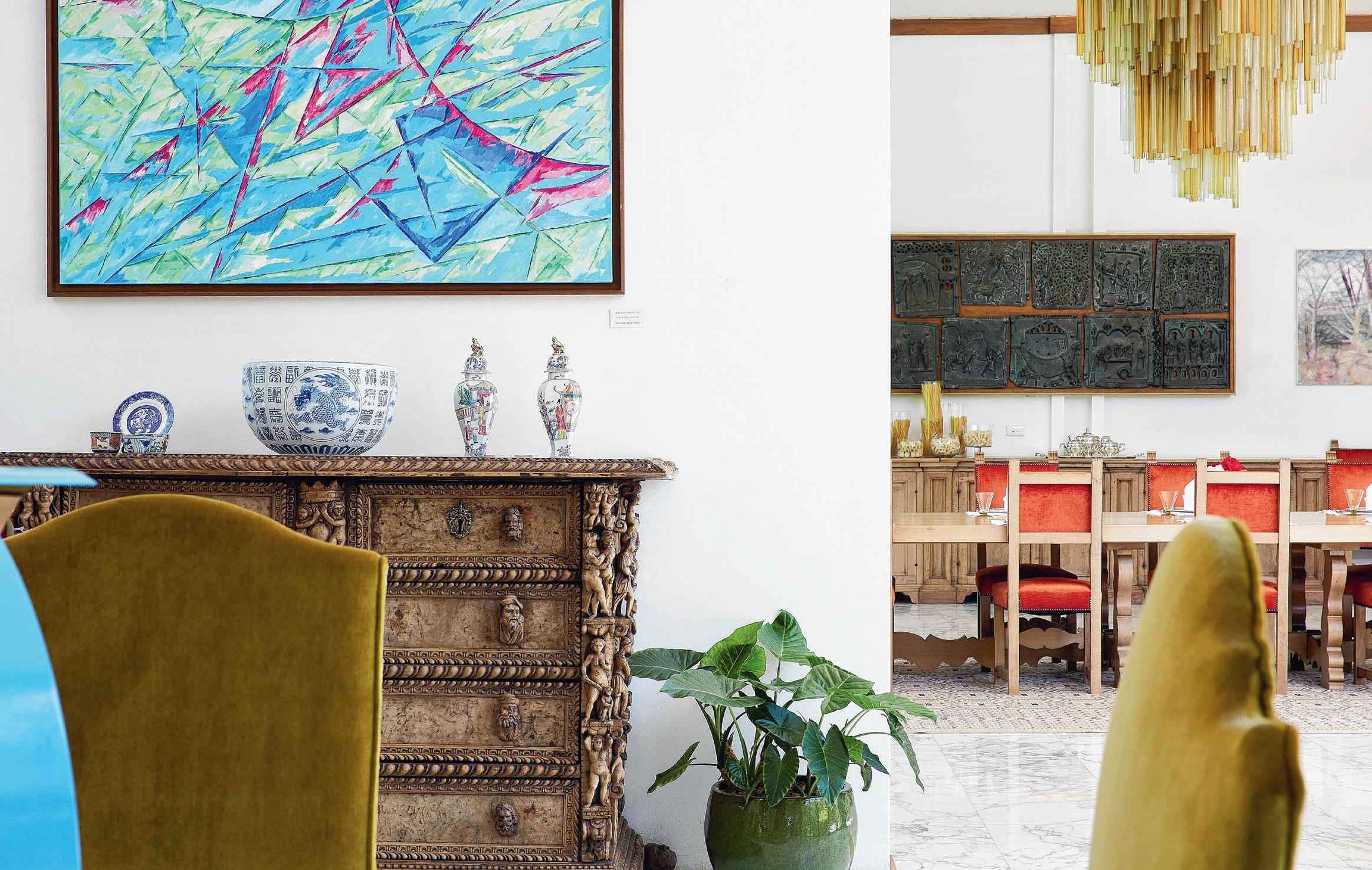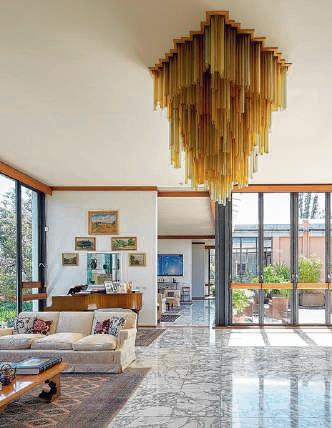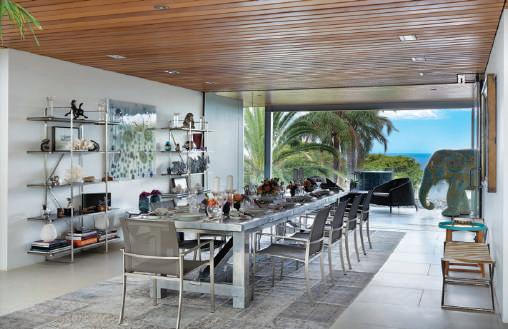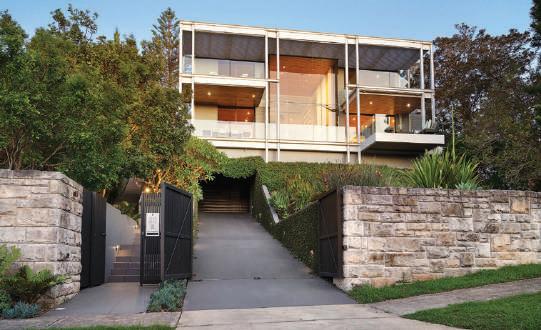
9 minute read
COVER STORY
from Mansion March 2020
BY JONATHAN CHANCELLOR
With many more diplomats trading their grand bases for city offices, some fine addresses have come up for sale
Advertisement
Foreign exchange


he formal residences of foreign diplomats are often homes of enviable allure, and until recent times were frequently tightly held. The Canberra home of the Italian consul-general highlights their showcase status. The property, which is unlikely to ever be put up for sale, was the work of late architect Enrico Taglietti, who was commissioned to find a place for the Italians. Completed in 1974, the Deakin premises are still one of the finest consular homes in the country.
Taglietti, who went on to receive the RAIA Gold Medal for Architecture, endeavoured to create a historical connection to Italian architecture and culture, with a focus on the villa designs of Ancient Rome. He considered Canberra “the dream of any modern architect”, proclaiming it “A city without towers, without golden domes, without cathedrals, a city without a past.”
Designed in the late 20th-century stripped classical style, the Italian ambassador’s home (pictured left) was built in a figure-of-eight design, with two interior courtyards wrapped by wide corridors and rooms.
There was an era when owning property in proximity to residential embassies held considerable cachet. Back then, neighbouring Sydney homes were advertised as being in consular heartland with Woollahra, Bellevue Hill and Vaucluse the hotspots.
According to veteran agent Michael Dunn, foreign governments gravitated to what was always considered prime blue ribbon real estate. Vaucluse had the UK consul in residence. Bellevue Hill had the Japanese, the French and Malaysians. The US swapped Darling Point for Woollahra.
However, over the past two decades there has been a downsizing and exiting from showcase embassies. The former French abode, Le Manoir in Bellevue Hill, was sold in 2009 because the French trade commissioner, Jean Louis Latour, was departing and his replacement was to live in Canberra. The French, who had owned the six- bedroom home since 1956, were responding also to the global financial crisis.
The Bulgarian consulate departed Double Bay in 2004 but it retains the prime Carlotta Road site, which has become rundown and unused. The country now has its consulate in the ACT.
Many departures left behind a litany of stories highlighting the difficulties of living in the neighbourhood. The exodus continues, in part as cash-strapped governments look to cash in their far-flung holdings and lease properties instead.
The biggest consular cluster centres on Trelawaney Street, Woollahra. The German Consulate, bought by the Federal Republic of Germany in 1974, went under offer earlier this month, four years after the consulate moved closer to the Sydney CBD, to Woolloomooloo.
The purchase was registered in 1.54 million German D-Marks when it was bought from German entrepreneur and patron Erich Glowatzky.
The full-brick, eight-bedroom residence, recently sold, was listed with $16 million hopes by Ray White Double Bay agents Craig Pontey and Elliott Placks. It is currently set up as 12 ground-floor offices, a cashier’s desk, with nine upper-level office spaces, and kitchenettes and toilets on each floor. There are private living quarters upstairs.
Pontey says the German Consulate followed the trend of consulates and embassies moving into the city. “They moved the business into office space and the consul general rented premises to live in,” he says.


The Lebanese remain on Trelawney Street, with the recently renovated Turkish consulate around the corner on Ocean Street, Woollahra.
The Yugoslavs spent $400,000 on Trelawney Street in 1977. The Polish have owned the corner of Trelawney and Fullerton Street since 1972, when they paid $165,000 for the property. The Russians are on Fullerton Street, having paid $314,000 in 1974 for their seven-storey office compound.
The Consulate of Finland residence in Bellevue Hill sold for $4.55 million in 2012 through Richardson & Wrench agents Michael and James Dunn. It was developed into a modern apartment block, retaining a part of its history with the name “Embassy on Redleaf”. “The grand residences had fantastic garden parties, but times are changing,” Michael Dunn says.
The Sydney consulates extend further than the consular belt, with the Indonesian Consulate General on Rose Bay’s Kent Road.
Veteran Kay & Burton agent Gerald Delany says a consular belt occurance never occurred in Melbourne, although Toorak had long been a magnet. The US and China have abodes in Toorak, with the US on Albany Road and China on Irving Road.
“Living near the American consulate provides very good security, however the Chinese consulate near the corner of Irving and Toorak Road has resulted in parking difficulties and there’s a constant presence of protestors to do with Falun Gong,” Delany notes.
He says many consular residences are unidentifiable. “I actually can’t nominate any other residences here in Melbourne. I can only assume that for security reasons they are not very visible.”


Much of the consular administrative representation in Melbourne is in St Kilda Road.
The cocktail party traffic in the well-heeled suburbs can be an annoying issue unless you are invited but there’s always the more troubling prospect of demonstrations, depending on events back in the homeland. A boy who climbed over the wall at the Yugoslav consulate in Woollahra was shot in 1988 by a security guard standing on its balcony during an annual demonstration against the creation of the Croatian republic in 1945. In 1999, Kurdish protestors armed with firebombs descended on the Greek consulate in Sydney. However, security in the streets around consular homes is provided free of charge by patrolling Australian Federal Police.
The US embassy departed its 1930s Darling Point trophy home Craigend in 1986 when the harbourfront property was sold to developer Bernard Lewis. The official reason was that it was difficult to secure a waterfront home against terrorists. However, it was whispered in diplomatic circles that the Canberra-based US ambassador, was living in a property inferior to Craigend, which was occupied by the American consul-general.
Not that the shift to Georgian Woollahra was slumming it. The US paid $2.175 million to buy the replacement home of consul general John Dorrance on Wallaroy Road. The 1560sq m property had plenty of pedigreed previous owners, including Australian National Industries, which owned in the 1950s.
Just as the practice of corporations owning trophy homes for their chief executives has declined, Christie’s International agent Ken Jacobs believes that foreign governments are no longer prioritising being part of a consular belt. “It appears the focus is more on Canberra than the states,” he notes.

Jacobs nearly sold one of Sydney’s best-known trophy homes to China in the mid-1990s. The Darling Point mansion Swifts had attracted the attention of the Chinese Government, before it was snapped up by the Moran healthcare family.
The Japanese are still on Bellevue Hill’s Rose Bay Avenue, having paid $627,500 in 1975 when buying from property developer Frank Theeman. Further up the hill, the Federation of Malaysia bought a property for $150,000, in 1971.
Few consulates are now on the waterfront, the exception being that of the Thai Government, which paid $3.75 million in 1999 for ad man Don Morris’s Alex Gencur-designed waterfront in Mosman.
The UK has listed its consular residence in Vaucluse through Savills. “The numbers are dropping,” Savills agent Martin Schiller says, adding that the Canadians sold on nearby Wentworth Road for $10.575 million in 2015.
“Consulate properties generally attract strong buyer interest, because they are substantial homes on large land in highly regarded streets, and have usually been well maintained,” Schiller says. “They are often architecturally significant and offered for the first time in many years.”
The last of the acquisitions, many outside the traditional consular belts, appeared in the 1970s.
The Government of Fiji opted for Frenchs Forest when it paid $91,500 for a property but sold it more than two decades ago. The Government of Papua New Guinea sold the Lindfield home of its consul for $950,000 in 2002, having bought the 1930s residence for $57,000 in 1975.
There are few sales on the Canberra diplomatic scene, and indeed there was a recent acquisition by the Vietnamese Government in O’Malley. It was a residential purchase rather than a relocation for the embassy.
Mario Sanfrancesco at Peter Blackshaw Real Estate says most diplomats have gravitated to O’Malley and Yarralumla, especially to Empire Circuit. There are also a few located on Mugga Way. “I have also found buyers that have enjoyed the multicultural aspect of living next door,” he says.
A few doors down the road from the Thai Embassy on Mugga Way is a 1930s Art Deco home for sale with prestigious possibility for embassy ownership. Belle Kingston agent Louise Harget and Dan McAlpine are marketing the gated fivebedroom 2325sq m estate.
Locals had the chance to step into the Italian Embassy in Deakin when it was open to the public as part of the Design Canberra Festival as an initiative of the Italian Ambassador, Stefano Gatti. Enrico Taglietti, who first came to Canberra in the 1950s, opted for a white palette under a flat roof. With perfect symmetry, tall, narrow windows line the facade and accentuate its grand double-storey height. Inside, there are Murano glass chandeliers, proudly displaying Italian craftsmanship, and portraits of Italian monks and aristocrats adorn the walls.

Visionary design, awe-inspiring views and every conceivable luxury VAUCLUSE 20 Ray Avenue


In a unique hill-top location, this contemporary masterwork holds a coveted cul-de-sac setting with panoramic unobstructed views over Sydney Harbour. Designed by award-winning architect Michael Dysart, the sprawling residence is set on a private 1,233sqm approx landholding with rare dual perspectives over both the harbour and Pacific Ocean. A sleek modernist aesthetic allows the vista to take centre stage with walls of glass framing views centred on the Harbour Bridge. Crowned with a unique rooftop entertainer’s terrace with 360-degree views, the property features lift access to all levels. Taking cues from the Japanese ideals of purity and simplicity, the home is designed around a dramatic double-height internal atrium that bathes interiors in light. The exceptional layout features multiple living areas, a parent’s retreat, guest suite, state-of-the-art kitchen, home cinema, rumpus room/ gym, temperature-controlled wine cellar, heated pool and sauna/steam room.

5 BED | 5+ BATH | 2 CAR
FOR SALE By Expressions of Interest
INSPECT By appointment
UNDER CONSTRUCTION


RESIDENTS LOUNGE
ROOFTOP POOL

CITY LIVING REDEFINED Luxury 2, 3 & 4 Bedroom Residences from $547,000 Under Construction by Condev - Completion expected Oct 2021
An Alluring Opportunity - Expertly designed by the award-winning BDA Architects, Allure comprises of world-class residences with luxurious resort-style amenities. The 17 level masterpiece enjoys exceptional panoramic views of the coast, hinterland, waterways and skyline combining inner city-living with inspirational natural surrounds. Our oversized residences are truly designed for living with all the little luxuries.
NOW SELLING - FOR MORE INFORMATION CALL OR SMS 24/7










